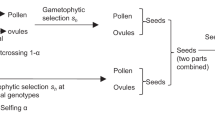Summary
Multi-locus self-incompatibility systems offer few obvious adaptive advantages to the species possessing them. However, the gametophytic system's independent gene action allows the separate genes in a two gene system to behave as if they were individually not involved in a systematic disruption of panmixia. Under such circumstances, fixation of one of the two genes is readily obtained if an allele possesses a selective advantage. The resulting single gene system (the classic Nicotiana system) is then resistant to disruption, except by genes which allow selfing, which rapidly reach fixation.
Similar content being viewed by others
References
Anderson GJ, Stebbins GL (1984) Dioecy versus gametophytic self-incompatibility: a test. Am Nat 124:423–428
Anderson MA, Cornish EC, Maul S-L, Williams EG, Hoggart R, Atkinson A, Bonig I, Grego B, Simpson R, Roche PJ, Haley JD, Penschow JD, Niall HD, Tregear GW, Coghlan JP, Crawford RJ, Clarke AE (1986) Cloning of cDNA for a stylar glycoprotein associated with expression of self-incompatibility in Nicotiana alata. Nature 321:38–44
Bateman AJ (1947) Number of S-alleles in a population. Nature 160:337
Bodmer WF (1984) Sex and generations of primroses. Nature 310:731
Brown AHD, Matheson AC, Eldridge KG (1985) Estimation of the mating system of Eucalyptus obliqua L'Hérit by using allozyme polymorphisms. Aust J Bot 23:931–949
Charlesworth D (1979) Some properties of populations with multilocus homomorphic gametophytic incompatibility systems. Heredity 43:19–25
Cheliak WM, Dancik BP, Morgan K, Yeh FCH, Strobeck C (1985) Temporal variation of the mating system in a natural population of jack pine. Genetics 100:569–584
Fisher RA (1947) Number of self-sterility alleles. Nature 160:797–798
Fisher RA (1941) Average excess and average effect of a gene substitution. Ann Eugen 11:53–63
Lande R, Schemske DW (1985) The evolution of self-fertilization and inbreeding depression in plants. I. Genetic models. Evolution 39:24–40
Leach CR, Hayman DL (1987) The incompatibility loci as indicators of conserved linkage groups in the Poaceae. Heredity 58:303–305
Leach CR, Mayo O, Morris MM (1986) Linkage disequilibrium and gametophytic self-incompatibility. Theor Appl Genet 73:102–112
Lundquist A (1958) Self-incompatibility in rye. IV. Factors related to self-seeding. Hereditas 44:193–256
Lundquist A (1960) The origin of self-compatibility in rye. Hereditas 41:1–19
Lundquist A (1968) The mode of origin of self-fertility in grasses. Hereditas 59:413–426
Mayo O (1966) On the problem of self-incompatibility alleles. Biometrics 22:111–120
Mayo O (1971) Rates of change in gene frequency in tetrasomic organisms. Genetica 42:329–337
Mayo O (1978) The existence and stability of a three-locus gametophytically-determined self-incompatibility system. Adv Appl Probab 10:14–15
Mayo O (1983) Natural selection and its constraints. Academic Press, London
Mitchell-Olds T, Waller DM (1985) Relative performance of selfed and outcrossed progeny in Impatiens capensis. Evolution 39:533–544
Piper JG, Charlesworth B, Charlesworth D (1985) Primroses and self-fertilization. Nature 311:418
Schemske DW, Lande R (1985) The evolution of self-fertilization and inbreeding depression in plants. II. Empirical observations. Evolution 39:41–52
Visser T, Marcucci MC (1984) The interaction between compatible and self-incompatible pollen of apple and pear as influenced by their ratio in the pollen cloud. Euphytica 33:699–704
Waller DM (1986) Is there disruptive selection for self-fertilization? Am Nat 128:421–426
Weber WE, Wricke G, Trang WS (1982) Genotypic frequencies at equilibrium in a multilocus gametophytic incompatibility system. Heredity 48:377–381
Author information
Authors and Affiliations
Additional information
Communicated by H.F. Linskens
Rights and permissions
About this article
Cite this article
Mayo, O., Leach, C.R. Stability of self-incompatibility systems. Theoret. Appl. Genetics 74, 789–792 (1987). https://doi.org/10.1007/BF00247558
Received:
Accepted:
Issue Date:
DOI: https://doi.org/10.1007/BF00247558




